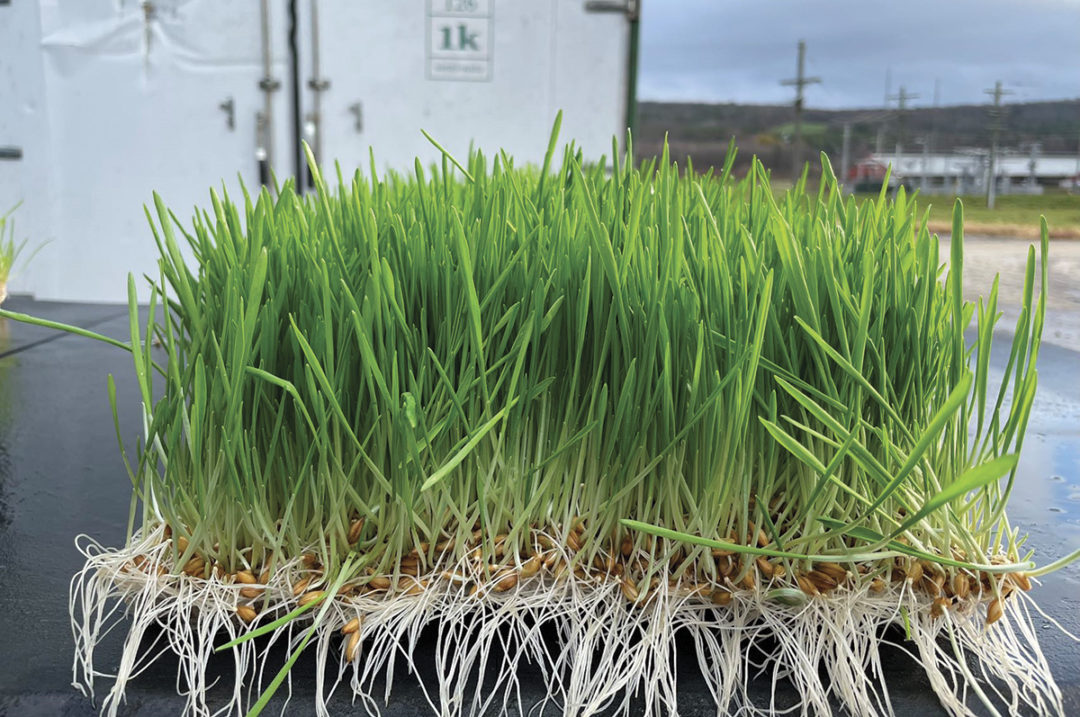You may be asking yourself, “What are hydroponic forages?” The word "hydro" means water and "ponics" comes from the root word meaning work. To put it simply, it means working with water, and in this case, it entails using water and a little bit of light to grow or sprout wheat and barley seeds.
“Hydroponics refers to a growing practice where you can grow grasses in a controlled environment without the requirement for soil,” says Joe McFadden, research lead at Cornell University.
Land shortages and drought conditions have caused hydroponic forages to gain interest in recent years. As it becomes more difficult for farmers to access quality forage, they have started to look at other options for producing feed. There is interest in these systems to replace land as a forage production center.
“If we can overcome the labor demands with automation, hydroponics has the potential to reduce costs of feed production and provide some consistency in the diet over traditional forages,” McFadden says. “And as we think about the future of a carbon credit economy and how we reduce natural resource use, discussions that focus on hydroponic feed production have merit.”
Looking back at the scientific history of hydroponic forages, McFadden found few controlled studies that investigated the inclusion level of sprouted grains and plant cultivars. He also realized U.S. dairy farmers typically want to feed a total mixed ration (TMR) in a conventional feeding system.
“The question was, ‘How can we still feed a conventional total mixed ration but include wheat or barley sprouts in the diet,’” McFadden says. “To allow for a fair comparison between a diet with or without sprouts, we had to swap out certain ingredients. In this particular case, we wanted to swap out the concentrates. We realize some concentrates can be a bit more expensive to purchase and require soil to grow. So we partially replaced four different concentrates, those being soybean meal, soybean hulls, canola meal and dextrose, and created three different dietary groups. One control with those four concentrates in a conventional TMR and two experimental diets with a little bit less of those concentrates, but with 10% either sprouted barley or sprouted wheat on a dry matter basis.”
McFadden’s goal was to determine the impacts on milk production, milk composition and nutrient digestibility in Holstein dairy cows. A total of 24 cows received treatment in a Latin square design. Three treatment groups of eight cows per treatment were analyzed in 21-day experimental periods.
Results from the study showed there was no change in milk yield or composition, no change in energy-corrected milk yield, a small decrease in dry matter intake (DMI) and an increase in efficiency to make milk.
“This is important because it demonstrates this replacement strategy by including sprouts and less concentrate cows were able to maintain their productive performance and actually enhance efficiency,” McFadden says. “This was especially observed in cows fed barley.”
To McFadden the most interesting finding from the study was that performance was not compromised.
“We did expect a drop in feed intake because there is greater water content in sprouts,” McFadden says. “However, at a 10 percent inclusion level we didn’t see any negative impacts on animal performance.”
The sprouted barley or wheat was around 14% to 18% on a dry matter basis.
“On a dry matter basis, they are quite nutrient-dense and have a nice profile of being moderately high in soluble protein, starch and sugars,” McFadden says. “That's why they're attractive because they could potentially replace a variety of ingredients.”
When looking at a 6-to-10-inch sprout, one may think it is photosynthesizing and gaining mass with the growth of the sprout. However, there is very little or no increase in mass within the six-day growing period.
“You pretty much get what you get from the seed when it is converted into a sprout. Even though it is green and there may be a little bit of photosynthesis happening, it's not enough to produce extra mass in that sprout,” says Rob Harding, head of microgreens at Renaissance Ag. “So basically, what you put in with the seed is what you get out with the sprout on a dry matter basis.”
During the sprouting and germination process, the seed produces enzymes like amylase which break down starch, lipases that break down complex fats and proteases that break down complex protein into simpler amino acids and peptides. These all help the diet become more digestible and can enhance total diet digestibility.
“Sugars in dairy rations have a positive effect on intakes and are also safer in the rumen of a cow than high-starch diets. They are also typically higher in protein,” Harding says. “A couple more advantages include a bump in vitamins and phytonutrients that add health benefits to the animal. And finally, for those interested in feeding it to close-up dairy cows, it tends to have a very low DCAD value and can fit very beautifully into close-up dairy cow diets.”

The big squares of sprouted barley or wheat are called fodder biscuits. Photo courtesy of Renaissance Ag.
In McFadden’s study, the hydroponic forage system was housed inside a shipping container and was semi-automated, meaning every day someone would have to go out and load seed trays and also harvest the fodder biscuits.
“Fodder biscuits are big squares of fodder,” McFadden says. “In order to feed it, someone would have to disrupt or shred the root mat in order to include it in a TMR, otherwise there would have been substantial sorting.”
Twenty years ago, hydroponics was a lot more labor-intensive than it is today, but there’s still a labor requirement, says McFadden. In the experimental setting, we were probably putting in more hours than if we were to apply this in a commercial setting.
“I think with time the technology will improve and that the labor demand will continue to decrease,” McFadden says.

In order to feed the fodder biscuits in a total mixed ration it is key to disrupt or shred the root mat to prevent sorting. Photo courtesy of Renaissance Ag.
One of the major challenges for the study was ensuring consistent production growth every single day.
“One thing we observed was, if for some reason the electricity turned off for a couple hours or the water was turned off by mistake, any small change could have a long-term impact on the growth performance,” McFadden says. “We grew the sprouts for six to seven days before harvest, but if one thing went wrong, then it not only impacted that day's harvest but impacted the performance of harvest for the next five days.”
Another concern typically seen with hydroponics is mold growth.
“If you keep the temperature low enough it doesn't impact sprout growth; one can completely avoid the mold issue. If it gets really hot in there, then there’s the chance of developing mold," McFadden says. “In our case, mold was not a concern at all.”
In the future, McFadden is interested in understanding the environmental impacts such as enteric methane emissions and nitrogen retention of using hydroponics over soil-based systems, as well as figuring out ways to retain as much dry matter as possible from seed to sprout moving forward.





